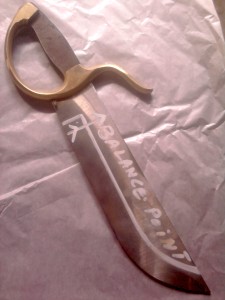We will now take a look at the balance of the swords. This is something that is critical to get right and is determined by how you will use the sword (chopping, stabbing, flipping, etc). Let’s look into the details of balancing a sword.
Sword Balance
Point of Balance
Point of Balance: The physical point of balance of the sword.
A poor point of balance, or misbalance, will be instantly apparent when a Butterfly Sword is used as intended. The ideal center of balance applicable to a longer sword like a Jian is generally one-third from the hilt up the blade toward the tip. This placement can be inappropriate for a Butterfly Sword that must be flipped 180 degrees between a forward and a reverse grip because a center of balance too far down the blade makes the weapon difficult and dangerous to flip.
There is no formula that determines the best point of balance for a Butterfly Sword. The optimal point of balance is typically in the center of the blade within an inch of a point abou t as far down from the handle towards the tip as the end of the quillon, but it all depends on the sword. This commonly preferred point of balance provides a good combination of speed and heft, allowing for powerful slices and chops as well as quick covers or blocks. It also permits knives with hybrid or flipping D Guards to be flipped with the greatest ease and least risk.
t as far down from the handle towards the tip as the end of the quillon, but it all depends on the sword. This commonly preferred point of balance provides a good combination of speed and heft, allowing for powerful slices and chops as well as quick covers or blocks. It also permits knives with hybrid or flipping D Guards to be flipped with the greatest ease and least risk.
At least one Wing Chun lineage and the occasional Sifu experimenting desires a point of balance further down the blade towards the tip – well past the point of balance of a War Era sword — creating a weapon with characteristics more like a machete. The forward point of balance makes the knife effectively much heavier and slower, with all that entails.
The combination of a heavy weapon and an extended center of balance can turn a fine instrument into a bludgeon that can be characterized as a “wrist breaker” and injure the attempted user. If you are going to practice with one, ease into it carefully. Although you may prefer a more traditionally balanced Butterfly Sword for combat, when your physical conditioning improves so much that properly balanced combat weight knives feel light you may occasionally prefer heavy knives to get a good workout. Just remember to train diligently with knives weighted and balanced for combat so that your trained responses are those of a warrior rather than a weight-lifter.
A Butterfly Sword with the point of balance moved backwards to the front of the handle is effectively lighter and faster than a normally balanced knife, with all that entails. This point of balance also makes it more difficult or dangerous to flip.
This video is Part 8 of 10 on Choosing Butterfly Swords by Jeffrey Modell. This video goes along with the blog article, but does not follow the exact same order of topics. We apologize that the AUDIO is OUT OF SYNC. This is the way the camera filmed the footage, so there is little we can do about it (simple aligning will not work). We hope you get some benefit, regardless:
[youtube]http://youtu.be/Hs_v_x9Z0QU[/youtube]

One thought on “Choosing Wing Chun Butterfly Swords – Part 7 – Balance”